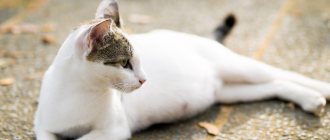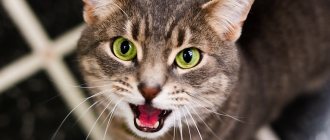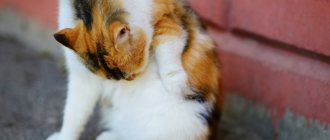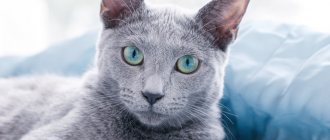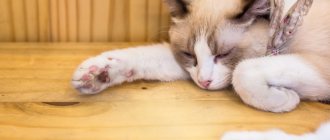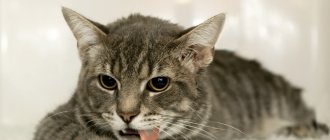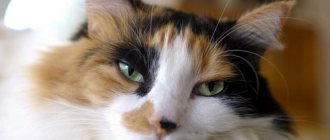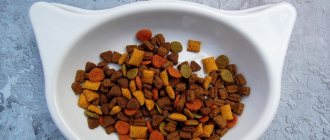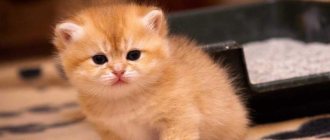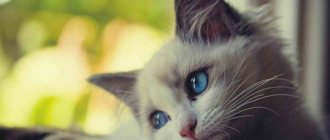- Posted by Ekaterina Gonina
- Date: November 11, 2018
Refusal of food and water for several days is a dangerous symptom, which in most cases indicates the presence of diseases of the internal organs. The greatest threat is posed by violation of the drinking regime. If an adult animal can go without food for 2–4 weeks, then in the absence of water dehydration and death quickly occur.
- 2 Signs of anorexia in cats
- 3 Should you contact a veterinarian?
3.1 Physiological norm
- 3.2 Dangerous condition
- 4.1 Table: diseases causing refusal of food and water
What is anorexia
Anorexia in cats is a syndrome characterized by a complete lack of appetite. The condition usually refers to mental disorders, since hunger is a physiological instinct, and the desire to eat is a psychological stimulus. Anorexia in most cases is associated with diseases of internal systems and organs. It is extremely rare that the disease is considered idiopathic.
When making a diagnosis and drawing up a treatment regimen, it is important to distinguish anorexia from pseudoanorexia. The first is associated with a complete lack of appetite. With pseudoanorexia, the cat wants to eat, but cannot eat due to pain or mental disorders. This form develops, for example, in diseases of the oral cavity.
Signs of anorexia in cats
The key signs of anorexia are refusal to eat and rapid weight loss. In the true form of the disease, the animal completely loses interest in food and turns away from the bowl. With pseudoanorexia, the cat sniffs the food and may even taste it, but later spits out the pieces and leaves the same way.
To understand whether an animal is suffering from severe emaciation, you need to pay attention to the ribs, hips, shoulder blades and thoracic region: with significant weight loss, the bones protrude
When dehydration sets in, the animal becomes less active. In mild cases, it can look like fatigue after playing games. Later, the animal becomes passive and does not make contact.
There are 3 stages of dehydration: mild, moderate and severe. Fluid loss is up to 5%, from 6% to 10% and more than 10%, respectively.
Depending on the cause of anorexia, the syndrome may be accompanied by other symptoms. For example, with intestinal infections, diarrhea appears, and if internal organs are damaged, swelling and bleeding occur.
Anorexia in a cat (refusal to feed)
The cat itches, but there are no fleas, it constantly licks itself
Anorexia is an eating disorder. In cats, it manifests itself as refusal to eat or, conversely, excessive gluttony. In case of gluttony, it is necessary to control the portion that the pet eats, otherwise it will lead to obesity.
When hungry, cats refuse not only their usual food, but also any offered treats. The cat does not eat, only drinks water, is lethargic, his sides are sunken - any owner will sound the alarm. The thin appearance of your pet is very frightening.
The reasons for fasting may be the following:
- stress;
- enzyme deficiency;
- hormonal disbalance;
- pancreatitis - inflammation of the pancreas;
- gastritis – inflammation of the stomach;
- enteritis - inflammation of the intestines;
- renal failure;
- liver diseases;
- infectious diseases;
- gastrointestinal diseases;
- pain syndrome;
- inflammatory processes in the body;
- shock.
A healthy kitten is active and has a good appetite.
The kitten does not eat or drink, is lethargic and sleeps constantly when it arrives at its new home. This can only be the norm if the animal shows more and more interest in people and in the food bowl every day. If something in the behavior of a small cat is alarming, it is better to call the breeder or a veterinary clinic.
Important! Kittens should absolutely not go hungry. As a rule, they are not afraid of liver lipidosis, but babies lose glucose (blood sugar) very quickly. This can lead to hypoglycemic coma.
Should I contact a veterinarian?
It is impossible to give a definite answer to this question. The owner should independently assess the pet’s condition and determine the advisability of treatment. If the refusal of food is partial, and the cat turns away from food, but eats its favorite treats, it is recommended to delay providing help. Perhaps it’s a matter of selectivity, which occurs for various reasons: from stress and bad mood to sexual desire.
Physiological norm
The norm may be partial or short-term complete refusal of food in the following cases:
- Recently had treatment or surgery. Aggressive medications can cause temporary (up to 2-3 days) weakness. This often happens after taking antibiotics, because they destroy the local microflora. To mitigate their effects and speed up recovery, pro- and prebiotics can be used.
- Vaccination was recently rescheduled. Most drugs contain weakened but living pathogens, to which the cat’s body independently develops immunity. This requires the mobilization of all internal resources, which causes partial or complete loss of appetite. Interest in water continues. Normally, a cat may refuse food for 1–2 days.
- The cat is having a fasting day. Some animals voluntarily refuse food every 2–3 months for up to 2 days. It is assumed that this is done instinctively to normalize the functioning of the gastrointestinal tract.
- The cat is pregnant or nursing kittens. Voluntary fasting may be associated with the imminent onset of labor or simple fatigue after the birth of babies. The cat drinks water but does not eat well for 1–2 days.
- The animal is in heat. During sexual heat, the reproductive instinct becomes the main one, so throughout the entire period the cat may eat poorly and lose weight.
Refusal to eat due to a runny nose due to colds does not require urgent correction. Subject to adequate treatment of the primary pathology, the nutritional schedule gradually normalizes. The same applies to hunger against the background of discomfort not associated with diseases. For example, a cat may go hungry due to stress after moving.
Dangerous condition
The threat is posed by refusal of water for 12 hours or more, as well as complete fasting for more than 3 days. Dehydration is more dangerous than exhaustion and occurs more quickly, so it is important to be able to correctly assess your pet’s well-being. This can be done using the following methods:
- Checking gums. It is necessary to quickly move the lip away and inspect the mucous membranes. Normally they are moist and shiny. When dehydrated, the body conserves moisture, so drying out occurs. An additional symptom is a feeling of stickiness in the gums. Drying occurs with moderate and severe degrees of dehydration. In such cases, urgent intervention is required. It is important to quickly assess the cat's condition, because upon contact with air, moisture quickly evaporates, which makes diagnosis difficult.
Normal gums should be pink in color.
- Skin pulling. You should carefully pinch the withers or skin. The second is preferable, because the skin on the withers is thicker and recovers more slowly, but this option is better suited for owners of aggressive animals. Once the fold is released, it should immediately smooth out. A slight delay may indicate mild dehydration. The danger comes from slowly smoothing the skin or maintaining the same position.
The grip and pull should be noticeable but not painful.
- Measurement of capillary refill rate. When dehydrated, blood volume decreases, it becomes more viscous, so its circulation slows down. To check, you need to lightly press on the animal’s gum, then release it and count the time until the color normalizes. The norm is 1–2 seconds. Delay occurs with severe dehydration, which requires urgent intervention. The most dangerous thing is pale gums even at rest.
To indirectly confirm the diagnosis, you can feel the animal's paw pads. If dehydrated, they will be cold. In the absence of other signs, a low temperature in itself does not indicate the presence of a deviation.
It is necessary to contact a veterinarian if there are any other specific symptoms: vomiting, weakness, reddening of the gums, etc. Additionally, a visit to the clinic is required if the animal is extremely exhausted.
If a kitten has lost its appetite, the possible fasting time is reduced to 4–12 hours, depending on age. If a six-month-old animal can maintain normal health when refusing food and water for 12 hours, then dehydration develops rapidly in a newborn baby. Sometimes only 4–6 hours are enough for death or irreversible changes to occur.
“Hungry diet” in cats before and after birth
A few weeks before the birth of the offspring, you may notice that your pet is not eating much . The reasons for this behavior are obvious - fast-growing kittens take up a lot of space in the abdominal cavity and the cat physically cannot eat the usual portion at one time. To avoid exhaustion, vitamin deficiency and the development of micronutrient deficiency, it is necessary to switch to fractional feeding.
Based on a balanced diet, the daily food intake is divided into 4-6 servings. In the last week before giving birth, it is advisable to feed the cat 4-5 times a day, every 2-3 hours.
Against the backdrop of increased needs and an increased diet, it is important to ensure that the cat does not gain excess weight. In the process of bearing kittens, obesity will lead to increased stress on the heart. During childbirth, most obese cats experience problems and complications.
6-12 hours before giving birth, the cat may completely refuse to eat. The period of hunger directly depends on the intensity of contractions. The first contractions may be weak and repeat at intervals of more than half an hour. In this state, the cat no longer eats, but continues to actively drink water.
Immediately after giving birth, the cat may continue to fast for another 5–6 hours. How quickly a cat begins to eat after giving birth directly depends on the load she has experienced.
After giving birth, the cat should not refuse water. If you are concerned that your pet is going too long without eating, try offering her broth, low-fat dairy products, a beaten egg, or sweet tea. If the treats are accepted, there is no cause for concern.
Important! If a cat does not eat well or refuses to eat after giving birth, this is a variant of the norm, which requires strict control. If a cat does not drink, this is a very alarming sign that requires immediate intervention.
Cats that have recently given birth may experience loose stools, especially if the birth of the kittens was not controlled by the owner. The fact is that the cat instinctively eats all the kittens' traces in order to restore electrolyte balance and nutritional deficiencies. If there are four or more kittens in a litter and the cat has eaten all the placenta, she is likely to develop severe diarrhea.
Diseases that are accompanied by refusal of food and water
Almost any pathology can cause partial or complete refusal of food and water. This most often occurs during exacerbation and the concomitant development of complications.
Pseudoanorexia often develops against the background of the following diseases:
- Gingivitis, stomatitis and other oral pathologies. In such cases, the cat wants to eat, but experiences pain in the process, so it refrains from eating. During a visual examination, it is possible to detect redness of the gums, tartar, ulcers, bleeding and other defects. To get rid of pain on its own, a cat may begin to chew hard objects. In this way, the animal tries to remove the problematic tooth.
Pink edges near the teeth are a characteristic symptom of gum disease.
- New growths on the tongue, tonsils or in the oral cavity. The tumors cause discomfort and may bleed. The main sign of disease is the presence of a neoplasm. It can be hard or soft, pink, white or black, depending on the type of pathology.
- Injuries and pathologies of the musculoskeletal system. In this case, refusal of food and water is associated with limited mobility. The cat becomes lethargic and inactive, moves little, limps, pulls its hind legs, etc.
With injuries and some diseases of the spine, the animal’s gait changes greatly, the most typical being failure of the hind legs
With pseudoanorexia, in all cases, appetite is not further adjusted. This is not necessary, since pets still have the desire to eat. In rare cases, with prolonged progression of the disease, negative associations are reinforced, but usually cats return to a normal diet within 2-3 weeks.
True anorexia can occur with many diseases: inflammatory, infectious, autoimmune, etc. We will note the most common causes.
Table: diseases that cause refusal of food and water
| Disease or condition | Characteristic symptoms | The need for treatment of concomitant appetite disorders |
| Internal organ injuries | Internal bleeding, blood in the stool (if the gastrointestinal tract is damaged), swelling and severe pain | No additional correction is required since this is an acute condition. The animal does not have time to lose much weight. Negative associations are not reinforced |
| Intoxication | Nausea, vomiting, drooling, digestive disorders | In most cases, it is enough to relieve intoxication, but in severe cases, intravenous fluid infusions are given and they switch to tube feeding |
| Lipidosis (accumulation of fat in the liver) | Lack of appetite for several weeks, rapid weight loss, diarrhea or constipation, vomiting, jaundice | Appetite correction is required. Many cats are malnourished, so they are offered high-calorie, high-protein foods. They try to carry out feeding in a familiar environment, eliminating stress factors. Correction is carried out until the animal begins to feed normally on its own. A probe can be used |
| Infectious diseases | Symptoms depend on the location of the pathology. Common signs include fever, weakness and pain | In most cases, no additional correction is required since this is an acute condition. After a short-term hunger strike and elimination of pathology, appetite normalizes on its own |
| Digestive tract diseases | Symptoms differ depending on the affected organ. If the functions of the pancreas are impaired, the digestibility of fats is impaired, and diarrhea is observed. With gastritis, body temperature sometimes rises. With most gastrointestinal diseases, the cat's gait changes: it hunches over due to pain | The need for additional correction depends on the condition of the animal. If the pet is not eating well even after the condition has returned to normal and has become very thin, a decision is made to change the diet. High-calorie gentle products can be used. For example, baby puree |
| Helminthiasis | With severe infection, worms are found in vomit and feces. A cat can lose weight even with an increased appetite. At some point, the animal refuses food due to a general deterioration in condition or intestinal obstruction | Discuss with veterinarian. In the absence of significant weight loss and short-term loss of appetite, the condition is not corrected. After using anthelmintic drugs in the absence of complications, appetite normalizes without third-party intervention |
| Any severe inflammatory processes | Symptoms depend on the type of disease. Often the animal’s appetite disappears due to pain during exacerbations of chronic pathologies | Depends on the condition of the animal. In case of long-term and severe course of the pathology, the pet during periods of remission may be offered more high-calorie food to restore normal physique |
| Impaired vision and smell | Loss of orientation in space. Smell disorders are detected through tests | In most cases, animals do not need strong correction. After therapy, the diet returns to normal. If it is impossible to treat the disease, owners are advised to use additional methods to improve appetite |
| Intestinal obstruction | Severe pain, vomiting, bloating. The stomach is hard. With partial obstruction, diarrhea is observed; with complete obstruction, constipation and absence of gas formation are observed. | If you contact a veterinarian in a timely manner, no additional measures are taken, since the animal does not have time to lose much weight |
Please note that these are only general recommendations. In each case, the veterinarian makes a decision individually, based on the pet’s condition. Even mild intoxication or antibiotic use can cause severe depletion in the absence of adequate care.
It also happens the other way around: with timely treatment and competent supportive therapy for gastrointestinal diseases, animals in most cases do not need separate treatment for anorexia. If a pet exhibits severe symptoms of dehydration or exhaustion, correction is necessary to prevent the occurrence of a critical condition.
Reasons why a cat may lose appetite
Desire is natural for any living being. Food provides energy to the body not only for activities directed outward (any movement), but also for the functioning of internal organs. Therefore, not eating for long periods of time is detrimental to health.
And then you notice that your pet, who until this moment was active and ate according to a schedule, suddenly ignores the bowl, and spends most of the time in a dormant state. It is necessary to determine the cause of the cat's changed behavior in order to provide her with the necessary help. Factors leading to refusal of food and water along with a decrease in activity may be psychological or medical.
Psychological
Psychological reasons include various stressful conditions for the animal:
- Moving to a new place of residence. Until the animal gets used to its new home, it may not only not feel the desire to eat, but also not go to the toilet. It is believed that an adult animal can behave this way for 2 days, and its condition does not require correction.
Everything in the new apartment is still foreign to the cat, she needs time to get used to it.
- Change of owner. Contrary to the prevailing opinion that a cat becomes attached to the house, and a dog to its owner, “their” person is also important for mustaches. Many cats choose their owner once and for all, and separation from him can cause deep stress for the animal.
- Change of diet. If a cat is suddenly switched to a new diet, it may refuse to eat at all, and lethargy will be a logical consequence of a weakening of the body.
- The appearance of a new pet or family member in the house, as well as guests (if they arrived for several days). Not all cats are friendly and easily accept any changes in their territory. Therefore, new people or animals are a stressful situation that you need to get used to. If people are noisy, and the animal psychologically suppresses the pet (for example, the owners got a dog that doesn’t like cats), then the stress can drag on.
Usually, even in a state of stress, a cat has a normal body temperature. But the appetite is completely absent, that is, the animal will not even touch the “yummy”.
A pet’s wet nose can serve as a relative indicator of general health (however, after sleep it can be dry, which is also the norm).
Medical
Another group of reasons for feeling unwell and refusing to eat is associated with the development of a disease. The main factors may include:
- Infectious and inflammatory diseases accompanied by fever. When fighting an infection, the body mobilizes all its reserves, so a pet may indeed not eat or drink for several days (just like a person, when he feels unwell, may not feel either the need for food or the desire to eat).
- Diseases of the urinary system. They are mainly associated with the formation of kidney stones and their movement through the ureters or blockage of the latter. The animal may experience severe pain and not approach the bowl, preferring to lie in a secluded place.
- Poisoning or gastrointestinal disorder. A pet can be poisoned not only by low-quality food, but also by household chemicals. Walking pets have a high risk of eating some poisonous insect or mouse, which in turn may already be poisoned. Against the background of intoxication of the body, the cat does not feel the desire to eat or drink, but it will have other symptoms (fever, vomiting, diarrhea).
- Injuries. Most often, injuries are manifested visually - the animal limps, experiences pain when moving (it may scream sharply or even bite when trying to pick it up). A type of injury may be a foreign body getting stuck in the throat. But even then the pet will cough, he may vomit, or wheeze when breathing.
- Diseases of the gums, teeth, and oral cavity. At the same time, the animal does not eat or drink simply because it hurts to do so. Older cats may refuse solid food due to their inability to chew it.
Inflammation of the gums in cats is a common reason for refusing to eat.
Loss of appetite and lethargy may also be caused by:
- helminthic infestations;
- infection with ectoparasites (fleas, subcutaneous ticks);
- allergic reactions.
During the period of sexual heat and estrus, female cats may not eat for several days.
My roaming cats generally disappeared from the yard for 2-3 days. Maybe somewhere they intercepted something like a mouse, but then they returned thin and hungry. Now they are all sterilized, but sometimes they also go away for a couple of days (I don’t know for what reasons). During this time I manage to change my mind, but then they come back and start eating off and sleeping off.
Medical causes are very diverse, each with specific symptoms. Only a veterinarian can accurately establish a diagnosis, and sometimes solely based on the results of tests and examinations. Therefore, in this case, you cannot self-medicate; it is better to rush to see a specialist.
The owner’s main task is to observe the animal and record various events that occurred before the change in the pet’s behavior and could play a role in its current condition. All this information will be needed at an appointment with a veterinarian in order to most fully describe the clinical picture of the cat’s well-being.
In kittens
In small kittens, the cause of lack of appetite and lethargy can be any infectious disease, as well as parasitic infestations (flea infestation can even cause severe anemia, which practically never happens in adult animals). For a small organism, this condition is more dangerous and can be fatal due to an imperfect immune system, faster dehydration and weakening of the body.
But stressful situations usually do not have a strong impact on children. They adapt much faster to any changed conditions and, on the contrary, show increased curiosity. And if symptoms of food refusal are observed for more than a day, then you should look for another reason for this.
Video: why a cat refuses to eat
How many days can a cat live without food and water?
Lack of water is more detrimental to a pet than refusal of food. An animal can live without obvious health consequences for no more than 2 days.
It has been observed that cats can live without water for up to 5 days. But at the same time, they will already experience irreversible changes in the functioning of organs and systems (primarily cardiovascular, urinary and nervous).
Cats can live up to 10 days without food if they constantly drink water. If the animal does not eat or drink, then after 5 days health problems will begin, including failure of vital organs (primarily the kidneys).
Diagnostics
To determine the reason for refusing food and water, a medical history is first taken. It is advisable to try to independently determine whether the animal wants to eat or is not at all hungry. It is important for the owner to note the moment of behavior change. Every little thing matters. It is necessary to inform the veterinarian about what the animal previously ate. You should pay attention to new uncharacteristic habits. For example, one day my colleague began to complain that her cat began to chew her shoes. Several months have passed. She said that the cat began to eat less and lost weight. At first I didn’t connect these 2 facts, but then during a preventive examination the animal was found to have helminths and tartar.
In case of severe exhaustion and dehydration, the cat is given first aid and symptomatic treatment even before diagnosis is made.
After questioning and examination, blood and urine are taken from the pet for analysis. The results help to detect diseases of the genitourinary system or gastrointestinal tract, as well as confirm the presence of an inflammatory process. With dehydration, the number of red blood cells increases (more than 10). It is advisable to have your stool tested to detect helminth and protozoan eggs. If the cause cannot be identified, a PCR study is performed. It helps detect pathogens of infectious diseases.
If tests for infections and general analyzes turn out to be uninformative, an ultrasound of the abdominal organs and a chest x-ray are performed. Studies help detect pathological changes in soft tissues and the musculoskeletal system. It is possible to identify hidden injuries. If the presence of inflammation in the gastrointestinal tract is confirmed, a biopsy and gastroduodenoscopy can be performed.
Hunger as a symptom of complications after childbirth
Unfortunately, refusal to eat, and often water, after childbirth can indicate serious complications. Most often, after giving birth, cats suffer from postpartum eclampsia.
Eclampsia, tetany or milk fever is a dangerous condition that leads to the death of the mother cat in a matter of hours. The cause of eclampsia is rapid loss of calcium, leading to hypocalcemia and organ failure. With eclampsia, after giving birth, the cat does not leave the nest and refuses food and water. In just a matter of minutes, the animal’s temperature rises and a severe fever begins. If at this time the kittens are suckling their mother, the condition develops very rapidly. If the kittens are removed from the breeding, the cat will act restless and try to get up. You will notice that your pet loses its balance and is poorly oriented in space.
The next stage is tremor. From this moment until the cat dies, no more than two hours will pass. Without urgent treatment and administration of calcium supplements, tremors will develop into seizures. Against the background of a complete inability to control its movements, the cat will develop acute disturbances in the functioning of the central nervous system and experience breathing problems. In this state, she opens her mouth and gasps for air, her gums look white or blue, and saliva drips from her mouth.
Important! While the cat is not having seizures, she needs to force milk with calcium gluconate into her mouth. If convulsions have already begun, the drug must be administered intravenously.
Refusal to eat, fever and severe shaking may indicate two more types of equally serious complications. Metritis is inflammation of the uterus due to a bacterial infection. In the initial stages, metritis is especially insidious because it is not accompanied by vaginal discharge. To protect your cat from complications, an ultrasound examination or x-ray should be performed in the last week of pregnancy in order to clearly know how many kittens should be born. During the birth process, it is important to control that all traces come out.
Postpartum bleeding is caused by damage to the birth canal or uterine walls, poor blood clotting, or other disorders. With postpartum hemorrhage, the situation can rarely be corrected only with medications; most often, the young mother has to undergo surgery. An exception is a violation of the blood composition, which can be restored through conservative therapy.
Ways to improve appetite
Deterioration in appetite is partly due to poor psycho-emotional background. It may be caused by pain, stress or discomfort. After the disease is eliminated, the negative reaction and poor appetite persist due to developed habits. To normalize weight, it is recommended to improve the psycho-emotional background of the animal. To do this, the pet is placed in its usual conditions, visits from guests and other changes are avoided, and the cat is also given its own private corner. It is recommended to place bowls, toys and a house there. It is advisable to purchase a special cat tree: the animal will be able to climb up and monitor what is happening around.
Play complexes allow the cat to feel safe
To normalize the psycho-emotional background and disappearance of residual effects after treatment, the pet needs to be provided with peace. When my cat lost weight due to gastritis, I introduced an unspoken rule at home: while the animal is in its house, no one should touch it. Cats guard their territory and do not like it when someone invades their personal space. They are not as social as dogs and need a break from human attention. The situation was complicated by the presence of a small child: the playtime of the younger family members often did not coincide, and the cat became nervous. She even slept lightly, but after gaining personal territory, everything gradually changed. Not immediately, but her appetite improved. The cat began to sleep better, play more willingly and eat more.
After normalization of the psycho-emotional background, they begin to correct the diet. All cats are individual, so you have to experiment to choose the optimal food recipe or finished product. You can change not only the ingredients and their proportions, but also the texture and shape of the pieces. If there are diseases of the oral cavity, it is advisable to offer the cat softened food or rounded food pellets. This will reduce injury to the gums and mucous membranes. You can give your pet baby puree by spreading a small amount on his paw. This will cause a reflex, and the cat will begin to lick itself. In some cases, this improves appetite.
Any new food must be offered under familiar conditions for the animal. When in a stressful situation, a cat will most likely refuse unfamiliar foods. It is advisable to alternate new dishes with old ones, giving the animal a choice. You can add some wet food or canned food to your usual food. Most of them contain ingredients that improve the taste and aroma of food. In my case, I was able to persuade my cat to eat an extra meal using Monge wet food with tuna. I added 1 tsp to each portion, stirred thoroughly and placed the bowl in front of her while she licked herself. At these moments the cat ate more willingly.
To change the taste and smell of food, you can use special mixtures for cats. For example, under the Mnyams brand they produce a seasoning with barley, linseed oil, yeast and blueberries. An unusual novelty can arouse interest in the animal.
If none of the suggested methods help, the veterinarian may prescribe medications if necessary. The most commonly used means are:
- Apilak. Contains royal jelly. It has a general strengthening effect, improves metabolism and increases appetite due to the presence of vitamins, minerals and acids in the composition. Refers to gentle drugs. Possible adverse reactions are allergies and sleep disorders. The standard dosage is half a tablet 2 times a day. They can be crushed and mixed with baby food or any regular food with a liquid consistency.
- Pernexin. B vitamins are used as active substances. They increase appetite and improve liver condition. It is recommended to avoid taking the drug in case of diseases of the cardiovascular system and bleeding. The product is produced in liquid form in 100 ml bottles. The dosage is checked with the attending physician. It is recommended to give cats no more than 2 ml of the drug per day, otherwise hypervitaminosis may develop.
- Peritol. The drug blocks the functioning of receptors that signal saturation. The product stimulates the production of serotonin and histamine. The first allows you not only to increase your appetite, but also to improve your psycho-emotional background. The medicine is produced in the form of syrup and tablets. The syrup contains ethanol, so it is not given to cats. Reception begins with 1/8 of the tablet 2 times a day. The animal is monitored and the dosage is increased if necessary.
If gentle medications do not help, Valium may be prescribed. It is used only under medical supervision and in short courses, as it can cause problems with the liver and kidneys. The dosage is selected individually.
Why doesn't my cat eat?
Let's look at the most typical reasons. The most common cases are when a pet shows no interest in food due to mild inflammatory processes in the uterus and parental tract. This happens after a difficult birth, when there are tears and other damage to the mucous membranes of the genital organs. Pain and other unpleasant sensations are not the best appetite stimulants.
Endometritis is especially dangerous. This is the name for inflammation of the uterus, in which intermittent fever occurs, leading to a serious deterioration in the animal’s condition. In cases of moderate inflammatory reactions, the cat’s condition will improve in about a couple of days, but you should not rest on this: if you do not provide the animal with the necessary medical care, the inflammation may become chronic.
Some cats, initially characterized by “nervous” characters, do not eat (or eat quickly and little by little) because they feel a threat to their kittens.
If other pets and people are constantly running around a basket with a cat and its offspring, your pet cannot relax. Try to move her and her droppings to a more isolated area.
But all this is “little things”. It is much worse when the owner, a couple of days before the birth, saw that the animal was behaving somehow strangely. Of course, in most cases, this is the norm for a pregnant cat in its final stages, but sometimes oddities indicate deadly pathologies and pathological conditions. Below we list the most common difficulties that veterinarians face in everyday practice. Not only do they suppress the appetite of a cat who has just given birth, but they can also contribute to her death.
Hemorrhages
This is the scientific name for bleeding . Note that the release of small amounts of bloody exudate immediately after childbirth is an absolutely normal, physiologically based phenomenon. The discharge should be reddish-brown and not have any noticeable odors. The “scents” of rot are a reason for an urgent visit to the veterinarian.
If bright red or burgundy blood clots are released from the cat’s genitals, this is bad. Such signs indicate the presence of intrauterine bleeding. Even slight bleeding over time can lead to anemia and a sharp deterioration in the animal’s well-being, causing the animal to eat little or completely lose its appetite.
Pathologies of the uterus itself
The "sac" that surrounded the kittens while they were still growing in their mother's womb is called the placenta or placenta (or "baby place"). The placenta must pass either during childbirth (this is most “correct” for cats), or immediately after it (maximum - within an hour).
Remember! Retention of placenta in cats is a severe pathology.
The baby's place remaining in the uterus during childbirth (since the cervix of the organ is open) is contaminated with bacterial microflora and begins to simply rot. This is clearly indicated by the presence of greenish-yellow or reddish-gray discharge from the external genitalia. The release of exudate is accompanied by the appearance of a truly unforgettable, strong putrefactive odor. In severe cases, it is impossible to be near the animal.
In addition, poor-quality and rude obstetric care often ends in a similar way, which is attempted by owners who do not have veterinary/medical experience. Note that due to severe intoxication, the cat not only eats poorly: it becomes very lethargic, apathetic, loose stools and other signs of serious health problems appear.
Alas, similar symptoms may be present with an incomparably more severe pathology - uterine rupture . This happens during very difficult, difficult childbirth, coupled with poor-quality obstetric care. In such cases, it is no longer possible to escape with “harmless” endometritis - such damage leads to peritonitis.
At the same time, the animal feels extremely bad; the cat eats poorly and does not care for the kittens. Moreover, if such pathologies are suspected, babies should be immediately transferred to artificial feeding, since breast milk will most likely contain a critical dose of toxins.
Mastitis
This is called inflammation of the mammary glands . It happens that this pathology is entirely the fault of “overgrown” kittens, which, having already acquired decent teeth, still continue to “milk” their mother. Since their long and sharp teeth constantly leave a lot of microscopic damage on the animal’s nipples, bacterial contamination of the damaged organ is almost guaranteed. Again, mastitis is a very (!) frequent complication of severe endometritis, since in the latter case pathogenic microflora may well enter the mammary glands through the general bloodstream.
In addition, mastitis often develops in especially “milk” cats, from whose nipples a valuable product constantly drains. In this case, pathogenic microflora can easily penetrate deep into the organ through the constantly open milk ducts. In the most severe cases, the mammary glands literally swell, they become hot and hard to the touch, and the milk turns into an unpleasant dark green or even yellowish substance. Of course, the cat doesn't eat anything. If you do not immediately contact a veterinarian, she may well die.
Hypocalcemia
Very severe postpartum pathology. If you decipher the term, it literally means “low calcium in the blood . This happens in pets that were initially not in the best physiological shape, and whose owners also did not pay special attention to feeding the animal. Watch out for symptoms of hypocalcemia! You should be alerted by pathologically fast breathing and nervousness of the animal, trembling, “wooden” walking, or the inability to stand up at all. What to do? Urgently contact a veterinarian, as this pathology cannot be treated at home!
Lipidoses as a consequence of prolonged fasting
If a cat, which is initially not very well-fed, for some reason does not eat for more than a day, it can expect the development of hepatic lipidosis . The problem is that the body of predators is not particularly good at processing subcutaneous fat reserves (if they exist at all), and therefore a lot of under-oxidized metabolic products end up in the liver. This significantly increases the workload of the organ and interferes with its normal functioning. Albeit occasionally, but such a situation can lead to fatty degeneration of the liver.
If your pet has lost weight and is not eating well, be sure to take her to the veterinarian. It definitely won't get any worse!
Prevention
Prevention of anorexia and water refusal consists of proper nutrition, avoidance of stressful situations and timely treatment of diseases. Many pathologies can cause these symptoms, so if any uncharacteristic signs appear, you should contact a veterinarian.
The cat must be switched to natural food or dry ready-made diets. Do not mix different types of food due to the risk of indigestion. The use of wet prepared foods is allowed, but they must alternate with granular products. Combining pates and dry rations into one feeding is also not allowed.
To maintain optimal condition, it is recommended that cats be given more red meat (beef and veal); chicken is a dietary variety
When eating natural products, 80% of the diet should be meat and offal. The rest is allocated to additives: vegetables and fermented milk. The menu should be varied. This allows the animal to receive different types of vitamins, minerals, amino acids and other beneficial substances. It is advisable to include chicken hearts, beef tripe, liver, fish, etc. in the diet.
Dry cat food should be at least super premium. Premium category products, when used for a long time, cause the development of metabolic disorders and pathologies of the gastrointestinal tract and kidneys. Economy class food is more dangerous because it contains a lot of salt and grains. If you have problems with appetite, it is important to consider the amount of ash in dry food. When I tried to switch my cat to Wellness Core dry food after her condition had normalized, she again began to sharply refuse to eat. It turned out that this is due to the high ash content - 9%. Conventionally, this indicator is considered the norm, but it is better to prefer 5–7%, otherwise the food will taste bitter.
How to feed a cat what they don’t want to eat, but need
How to get a cat to eat if he refuses to eat
If a cat refuses to take the food it needs and is healthy for it, there is no point in forcefully pouring or stuffing it all into it. It is necessary to introduce healthy foods into the diet from childhood, then no problems will arise with the varied nutrition of the animal.
A sick animal should be fed with small pieces, carefully placing them in the mouth. If the animal is so weakened after the illness that it cannot feed on its own, use meat broth, beaten eggs, and special food for sick animals. They are poured little by little from the bottle.
But the most important thing is a sufficient amount of drink, which, if necessary, is given from a pipette or using a horn.
The animal needs water every day, otherwise it is fraught with serious illnesses
